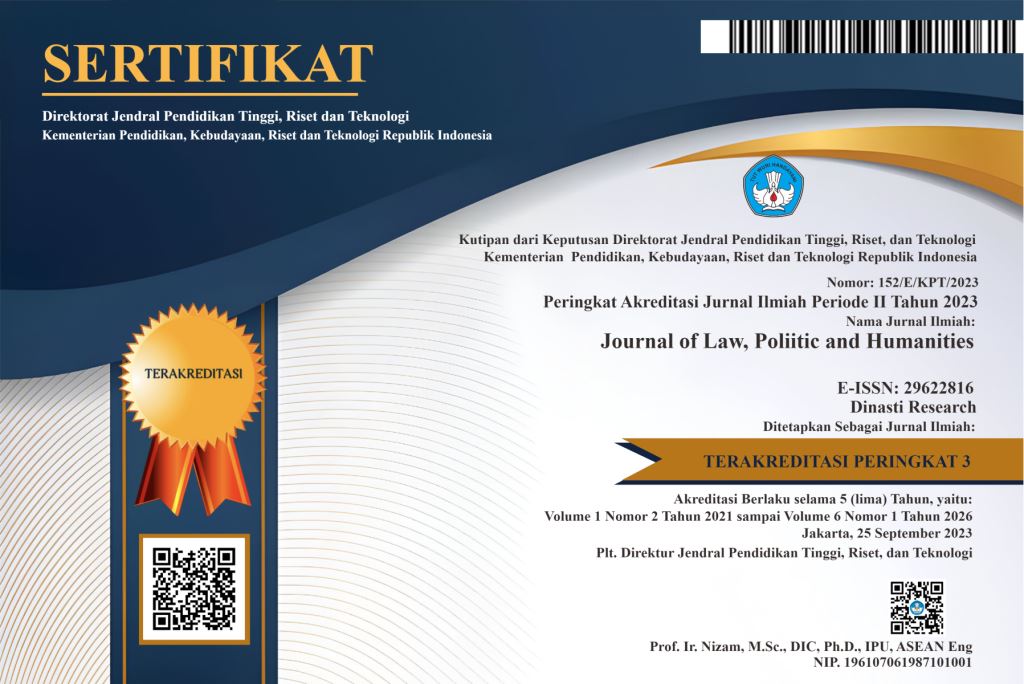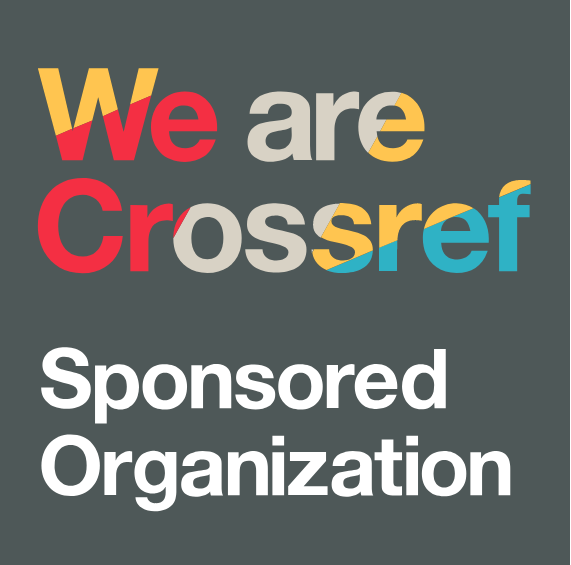Artificial Intelligence in Telemedicine: Regulatory Challenges and Legal Accountability in Indonesia
DOI:
https://doi.org/10.38035/jlph.v6i1.2475Keywords:
Keywords: Artificial Intelligence, Telemedicine, Legal AccountabilityAbstract
Abstract:Technological development has become a key catalyst in transforming various aspects of human life, including the healthcare sector, through telemedicine services. Telemedicine has emerged as an innovative solution to address challenges in healthcare access, particularly during the COVID-19 pandemic, by offering convenience, efficiency, and affordability. One of the supporting technologies that strengthens the telemedicine system is artificial intelligence (AI), which can analyze medical data, accelerate diagnosis, and monitor patients in real time. AI branches such as Natural Language Processing (NLP) also play a role in processing unstructured medical data, thereby supporting efficient documentation and clinical decision-making. However, the application of AI in telemedicine requires serious legal and regulatory attention. In Indonesia, the legal framework governing telemedicine and AI remains limited, lacks comprehensiveness, and is not yet legally binding. This situation raises ethical risks, algorithmic bias, and uncertainty regarding legal liability. Meanwhile, countries such as the European Union, Singapore, and Australia have designed adaptive regulations oriented toward patient safety and data protection. In facing these challenges, legal accountability from the Indonesian government is required as part of the implementation of good governance principles. The government must formulate clear, transparent, and inclusive regulations while ensuring the involvement of medical professionals in AI-based decision-making. Such measures will serve as strategic elements in building a safe, fair, and sustainable digital healthcare system.
References
Agency for Science, T. and R.-S. (2024a). 2024_wp001_ai-for-population-health-and-digital-health-in-singapore.
Agency for Science, T. and R.-S. (2024b). “Artificial Intelligence for Population Health and Digital Health in Singapore”.
Ali, F., Hamid, U., Zaidat, O., Bhatti, D., & Kalia, J. S. (2020a). Role of Artificial Intelligence in TeleStroke: An Overview. In Frontiers in Neurology (Vol. 11). Frontiers Media S.A. https://doi.org/10.3389/fneur.2020.559322
Ali, F., Hamid, U., Zaidat, O., Bhatti, D., & Kalia, J. S. (2020b). Role of Artificial Intelligence in TeleStroke: An Overview. Frontiers in Neurology, 11. https://doi.org/10.3389/fneur.2020.559322
Ardila, D., Kiraly, A. P., Bharadwaj, S., Choi, B., Reicher, J. J., Peng, L., Tse, D., Etemadi, M., Ye, W., Corrado, G., Naidich, D. P., & Shetty, S. (2019). End-to-end lung cancer screening with three-dimensional deep learning on low-dose chest computed tomography. Nature Medicine, 25(6), 954–961. https://doi.org/10.1038/s41591-019-0447-x
Australian Institute of Health and Welfare. (2019). Australia’s Health 2018.
Barry Elad, & Rohan Jambhale. (2025). Telemedicine Statistics By Revenue, Region, Products And Service (2025). Sci_tech.
Chaturvedi, U., Chauhan, S. B., & Singh, I. (2025). The impact of artificial intelligence on remote healthcare: Enhancing patient engagement, connectivity, and overcoming challenges. Intelligent Pharmacy. https://doi.org/10.1016/j.ipha.2024.12.003
Cunha Reis, T. (2025). Artificial intelligence and natural language processing for improved telemedicine: Before, during and after remote consultation. Atención Primaria, 57(8), 103228. https://doi.org/10.1016/j.aprim.2025.103228
Esteva, A., Kuprel, B., Novoa, R. A., Ko, J., Swetter, S. M., Blau, H. M., & Thrun, S. (2017). Dermatologist-level classification of skin cancer with deep neural networks. Nature, 542(7639), 115–118. https://doi.org/10.1038/nature21056
European Union. (2024). European Health Data Space Regulation (EHDS)-Public Health Section.
Gulshan, V., Peng, L., Coram, M., Stumpe, M. C., Wu, D., Narayanaswamy, A., Venugopalan, S., Widner, K., Madams, T., Cuadros, J., Kim, R., Raman, R., Nelson, P. C., Mega, J. L., & Webster, D. R. (2016). Development and Validation of a Deep Learning Algorithm for Detection of Diabetic Retinopathy in Retinal Fundus Photographs. JAMA, 316(22), 2402. https://doi.org/10.1001/jama.2016.17216
Hall Dykgraaf, S., Desborough, J., de Toca, L., Davis, S., Roberts, L., Munindradasa, A., McMillan, A., Kelly, P., & Kidd, M. (2021). “A decade’s worth of work in a matter of days”: The journey to telehealth for the whole population in Australia. International Journal of Medical Informatics, 151, 104483. https://doi.org/10.1016/j.ijmedinf.2021.104483
He, J., Baxter, S. L., Xu, J., Xu, J., Zhou, X., & Zhang, K. (2019). The practical implementation of artificial intelligence technologies in medicine. Nature Medicine, 25(1), 30–36. https://doi.org/10.1038/s41591-018-0307-0
Healthcare Services Act 2020 Singapore, Singapore (2020).
Heriyanto, H., & Sahrul, S. (2023). Hukum Perlindungan Konsumen dan Etika Bisnis di Era Teknologi Kecerdasan Buatan: Perlindungan Pengguna dan Tanggung Jawab Perusahaan. Jurnal Hukum Dan HAM Wara Sains, 2(09). https://doi.org/10.58812/jhhws.v2i09.674
HODGES, A. (2006). B. J ACK C OPELAND (ed.), The Essential Turing: The Ideas that Gave Birth to the Computer Age. Oxford: Clarendon Press, 2004. Pp. viii+613. ISBN 0-19-825079-7. £50.00 (hardback). ISBN 0-19-825080-0. £14.99 (paperback). The British Journal for the History of Science, 39(3), 470–471. https://doi.org/10.1017/S0007087406448688
Ismi Fadjriah Hamzah. (2024). TELE KESEHATAN DAN TELEMEDISIN: PERSPEKTIF HUKUM KESEHATAN. Jurnal Ilmiah Ilmu Sosial Dan Pendidikan, 2(2), 130.
Kaplan, A., & Haenlein, M. (2019). Siri, Siri, in my hand: Who’s the fairest in the land? On the interpretations, illustrations, and implications of artificial intelligence. Business Horizons, 62(1), 15–25. https://doi.org/10.1016/j.bushor.2018.08.004
Kauw, F., Heit, J. J., Martin, B. W., van Ommen, F., Kappelle, L. J., Velthuis, B. K., de Jong, H. W. A. M., Dankbaar, J. W., & Wintermark, M. (2020). Computed Tomography Perfusion Data for Acute Ischemic Stroke Evaluation Using Rapid Software: Pitfalls of Automated Postprocessing. Journal of Computer Assisted Tomography, 44(1), 75–77. https://doi.org/10.1097/RCT.0000000000000946
Kavitha Palaniappan, Elaine Yan Ting Lin, & Silke Vogel. (2021). “Global Regulatory Frameworks for the Use of Artificial Intelligence (AI) in the Healthcare Services Sector”, . PMDI Healtcare, 12(5), 563.
Kementerian Komunikasi dan Informatika. (n.d.). Penggunaan Aplikasi Telekonferensi Naik 443 Persen Sejak Pandemi. Kementerian Komunikasi Dan Informatika.
Kulkarni, P., Mahadevappa, M., & Chilakamarri, S. (2022). The Emergence of Artificial Intelligence in Cardiology: Current and Future Applications. Current Cardiology Reviews, 18(3). https://doi.org/10.2174/1573403X17666211119102220
Maulida, S., Amruzi, F. Al, Hakim, B. R., & Beik, I. S. (2024). Post-Pandemic Digital Transformation in Zakat Management: Insights From Maqasyid Syari’ah in South Kalimantan. El-Mashlahah, 14(2), 281–302. https://doi.org/10.23971/el-mashlahah.v14i2.7772
Mulyadita, U., Sutanto, E., Fiqri, M., Setiawan, E., Pattnaik, A., Mulyadita, U., Sutanto, E., Fiqri, M., Setiawan, E., & Pattnaik, A. (2025). Mapping Telemedicine in Indonesia: Evidence for Policy Action at a Critical Juncture. ThinkWell. www.thinkwell.global
Murdoch, B. (2021). Privacy and artificial intelligence: challenges for protecting health information in a new era. BMC Medical Ethics, 22(1), 122. https://doi.org/10.1186/s12910-021-00687-3
Murima, W. H., Prayogi, A. R. Y., Rahvy, A. P., Djunaedi, N., & Dhamanti, I. (2022). TELEMEDICINE USE IN HEALTH FACILITY DURING COVID-19 PANDEMIC: LITERATURE REVIEW. Jurnal Administrasi Kesehatan Indonesia, 10(2), 251–260. https://doi.org/10.20473/jaki.v10i2.2022.251-260
Nagel, S., Sinha, D., Day, D., Reith, W., Chapot, R., Papanagiotou, P., Warburton, E. A., Guyler, P., Tysoe, S., Fassbender, K., Walter, S., Essig, M., Heidenrich, J., Konstas, A. A., Harrison, M., Papadakis, M., Greveson, E., Joly, O., Gerry, S., … Grunwald, I. Q. (2017). e-ASPECTS software is non-inferior to neuroradiologists in applying the ASPECT score to computed tomography scans of acute ischemic stroke patients. International Journal of Stroke, 12(6), 615–622. https://doi.org/10.1177/1747493016681020
Nasir, G. A. (2017). KEKOSONGAN HUKUM & PERCEPATAN PERKEMBANGAN MASYARAKAT. Jurnal Hukum Replik, 5(2), 172. https://doi.org/10.31000/jhr.v5i2.925
Nasution, I. S., Andini, N., Hasmi, N., Ukandari, P., Zahra, P. Z., Nst, S., Pane, S. S., & Asri, S. A. (2024). Pengaruh Kebijakan Kesehatan Terhadap Pembangunan Ekonomi di Sumatera Utara. Journal of Education Transportation and Business, 1(2), 76–82. https://doi.org/10.57235/jetbus.v1i2.3206
Palaniappan, K., Lin, E. Y. T., & Vogel, S. (2024). Global Regulatory Frameworks for the Use of Artificial Intelligence (AI) in the Healthcare Services Sector. Healthcare, 12(5), 562. https://doi.org/10.3390/healthcare12050562
Personal Data Protection Commission Singapore. (2025). Overview PDPA.
Pesapane, F., Bracchi, D. A., Mulligan, J. F., Linnikov, A., Maslennikov, O., Lanzavecchia, M. B., Tantrige, P., Stasolla, A., Biondetti, P., Giuggioli, P. F., Cassano, E., & Carrafiello, G. (2021). Legal and Regulatory Framework for AI Solutions in Healthcare in EU, US, China, and Russia: New Scenarios after a Pandemic. Radiation, 1(4), 261–276. https://doi.org/10.3390/radiation1040022
Regulation (EU) 2017/745 of the European Parliament and of the Council of 5 April 2017 on Medical Devices, Pub. L. No. 745, Uni Eropa (2017).
Republik Indonesia. (2023). Undang-Undang No 17 Tahun 2023 tentang Kesehatan.
Shameer, K., Johnson, K. W., Glicksberg, B. S., Dudley, J. T., & Sengupta, P. P. (2018). Machine learning in cardiovascular medicine: are we there yet? Heart, 104(14), 1156–1164. https://doi.org/10.1136/heartjnl-2017-311198
Shanu Singh Chouhan. (2025). The Role of AI in Telemedicine: Legal and Regulatory Perspective. International Journal of Law Management & Humanities, 8(1).
Sharma, S., Rawal, R., & Shah, D. (2023a). Addressing the challenges of AI-based telemedicine: Best practices and lessons learned. Journal of Education and Health Promotion, 12(1). https://doi.org/10.4103/jehp.jehp_402_23
Sharma, S., Rawal, R., & Shah, D. (2023b). Addressing the challenges of AI-based telemedicine: Best practices and lessons learned. Journal of Education and Health Promotion, 12(1). https://doi.org/10.4103/jehp.jehp_402_23
Sharma, S., Rawal, R., & Shah, D. (2023c). Addressing the challenges of AI-based telemedicine: Best practices and lessons learned. Journal of Education and Health Promotion, 12(1). https://doi.org/10.4103/jehp.jehp_402_23
Sherly Primavita, Nayla Alawiya, & Ulil Afwa. (2021). TANGGUNG JAWAB HUKUM DOKTER DALAM PELAYANAN TELEMEDICINE. Soedirman Law Review, 3(4).
Shinta Lestari DG. (2021). Narrative Review: Telemedicine dan Impelentasinya dalam membantu Psien Covid-19 . Farmaka, 19(3), 63–72.
Statista. (2025). Telemedicine - statistics and facts.
Tawfik Masrour, Ibtissam El Hassani, & Anass Cherrafi. (2021). Artificial Intelligence and Industrial Applications (T. Masrour, I. El Hassani, & A. Cherrafi, Eds.; Vol. 144). Springer International Publishing. https://doi.org/10.1007/978-3-030-53970-2
United Nations Economic and Social Commission for Asia and the Pacific. (n.d.). “What is Good Governance”.
Vagal, A., Wintermark, M., Nael, K., Bivard, A., Parsons, M., Grossman, A. W., & Khatri, P. (2019). Automated CT perfusion imaging for acute ischemic stroke. Neurology, 93(20), 888–898. https://doi.org/10.1212/WNL.0000000000008481
World Health Organization. (1998). A health telematics policy in support of WHO’s Health-for-all strategy for global health development?: report of the WHO Group Consultation on Health Telematics.
World Health Organization. (2022). Consolidated Telemedicine Implementation Guide. World Health Organization.
Downloads
Published
How to Cite
Issue
Section
License
Copyright (c) 2025 Diah Arimbi

This work is licensed under a Creative Commons Attribution 4.0 International License.
Authors who publish their manuscripts in this journal agree to the following conditions:
- The copyright on each article belongs to the author(s).
- The author acknowledges that the Journal of Law, Poliitic and Humanities (JLPH) has the right to be the first to publish with a Creative Commons Attribution 4.0 International license (Attribution 4.0 International (CC BY 4.0).
- Authors can submit articles separately, arrange for the non-exclusive distribution of manuscripts that have been published in this journal into other versions (e.g., sent to the author's institutional repository, publication into books, etc.), by acknowledging that the manuscript has been published for the first time in the Journal of Law, Poliitic and Humanities (JLPH).


























